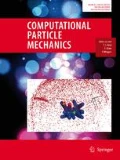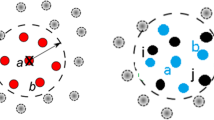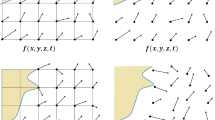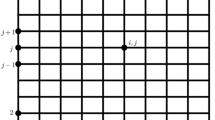Abstract
In this paper, we investigate the application of smoothed particle hydrodynamics (SPH) to the computation of 3-D flows in channels with sudden expansion or contraction. In the same context, we also discuss 2-D SPH computations applicable to channels characterized by cross-sections of large aspect ratios. The particle nature of SPH allows us to treat macro-systems similarly to atomic systems, transferring knowledge from molecular dynamics (MD) and dissipative particle dynamics (DPD) and suggesting a common framework for simulations at different scales. Computations are carried out by making use of tools previously used for atomic-scale systems (usually MD) and mesoscopic systems (usually DPD). The results obtained suggest that SPH captures the main flow characteristics and achieves good accuracy both in 2-D and 3-D, at least for Re values in the range 0.0177 to 55.4 investigated here. Minor numerical artifacts may be observed near the solid boundaries, especially at corner discontinuities. Such localized inaccuracies near points of geometric discontinuity are common in all numerical simulation methods.















Similar content being viewed by others
References
Shadloo MS, Oger G, Le Touzé D (2016) Smoothed particle hydrodynamics method for fluid flows, towards industrial applications: motivations, current state, and challenges. Comput Fluids 136:11–34
Monaghan JJ, Gingold RA (1983) Shock simulation by the particle method SPH. J Comput Phys 52(2):374–389
Monaghan JJ (1992) Smoothed particle hydrodynamics. Annu Rev Astron Astrophys 30:543–574
Khorasanizade S, Sousa JMM (2016) An innovative open boundary treatment for incompressible SPH. Int J Numer Meth Fluids 80:161–180
Kazemi E, Nichols A, Tait S, Shao S (2017) SPH modelling of depth-limited turbulent open channel flows over rough boundaries. Int J Numer Meth Fluids 83:3–27
Ye T, Nhan P-T, Chwee Teck L, Peng L, Shi H (2017) Hybrid smoothed dissipative particle dynamics and immersed boundary method for simulation of red blood cells in flows. Phys Rev E 95:063314
De Padova D, Mossa M, Sibilla S, Torti E (2013) 3D SPH modelling of hydraulic jump in a very large channel. J Hydraul Res 51(2):158–173
Nomeritae N, Bui HH, Daly E (2018) Modeling transitions between free surface and pressurized flow with Smoothed Particle Hydrodynamics. J Hydraul Eng 144(5):04018012
Adami S, Hu XY, Adams NA (2012) A generalized wall boundary condition for smoothed particle hydrodynamics. J Comput Phys 231:7057–7075
Olejnik M, Szewc K, Pozorski J (2017) SPH with dynamical smoothing length adjustment based on the local flow kinematics. J Comput Phys 34:23–44
Monaghan JJ, Kajtar JB (2009) SPH particle boundary forces for arbitrary boundaries. Comput Phys Commun 180(10):1811–1820
Ahmed WH, Ching CY, Shoukri M (2007) Pressure recovery of two-phase flow across sudden expansions. Int J Multiph Flow 33:575–594
Aloui F, Doubliez L, Legarand J, Souhar M (1999) Bubbly flow in an axisymmetric sudden expansion: pressure drop, void fraction, wall shear stress, bubble velocities and sizes. Exp Therm Fluid Sci 18:118–130
Nouri D, Pasandideh-Fard M, Oboodi MJ, Mahian O, Sahin AZ (2018) Entropy generation analysis of nanofluid flow over a spherical heat source inside a channel with sudden expansion and contraction. Int J Heat Mass Transf 116:1036–1043
Khan SA, Aabid A, Ghasi FAM, Al-Robaian AA, Alsagri AS (2019) Analysis of area ratio in a CD nozzle with suddenly expanded duct using CFD method. CFD Lett 11(5):61–71
Sato T, Harada K, Taniguchi T (2019) Multiscale simulations of flows of a well-entangled polymer melt in a contraction-expansion channel. Macromolecules 52(2):547–564
Caballero A, Mao W, Liang L, Oshinski J, Primiano C, McKay R, Kodali S, Wei S (2017) Modeling left ventricular blood flow using smoothed particle hydrodynamics. Cardiovasc Eng Technol 8(4):465–479
Wu T, Guo Q, Ma H, Feng JJ (2015) The critical pressure for driving a red blood cell through a contracting microfluidic channel. Theor App Mech Lett 5(6):227–230
Sofos F, Karakasidis TΕ, Spetsiotis D (2019) Molecular Dynamics simulations of ion separation in nano-channel water flows using an electric field. Mol Simul 45:1395–1402
Tang Y-H, Karniadakis GE (2014) Accelerating dissipative particle dynamics simulations on GPUs: algorithms, numerics and applications. Comput Phys Comm 185(11):2809–2822
Plimpton S (1995) Fast parallel algorithms for short-range molecular dynamics. J Comput Phys 117:1–19
Chatzoglou E. (2019) SPH based study of turbulent open channel flow with permeable bed. Dipl Thesis, University of Thessaly, Volos, GR
Tafuni A, Domínguez JM, Vacondio R, Crespo AJC (2018) A versatile algorithm for the treatment of open boundary conditions in smoothed particle hydrodynamics GPU models. Comput Methods Appl Mech Eng 342:604–624
Szewc K (2017) Smoothed particle hydrodynamics modeling of granular column collapse. Granular Matter 19:3
Seerha PPS, Kumar P, Das AK, Mitra SK (2017) Proposition of stair climb of a drop using chemical wettability gradient. Phys Fluids 29:072103
Shigorina E, Tartakovsky AM, Kordilla J (2019) Investigation of gravity-driven infiltration instabilities in smooth and rough fractures using a pairwise-force smoothed particle hydrodynamics model. Vadose Zone J 18:180159
Sofos F, Liakopoulos A, Karakasidis TΕ (2019) Particle-based modeling and meshless simulation of flows with smoothed particle hydrodynamics. Global Nest 21:513–518
Ganzenmüller GC, Steinhauser MO, Van Liedekerke P (2011) The implementation of Smooth Particle Hydrodynamics in LAMMPS. http://lammps.sandia.gov/doc/PDF/SPH_LAMMPS_userguide.pdf. Accessed 2011
Liakopoulos A, Sofos F, Karakasidis TE (2018) Modelling environmental flows with Lagrangian particle methods. In: Proceedings of the international conference on the protection and restoration of the environment 14 (PRE14)
Morris JP, Fox PJ, Zhu Y (1997) Modeling low Reynolds number incompressible flows using SPH. J Comput Phys 136:214–226
Ellero M, Adams NA (2011) SPH simulations of flow around a periodic array of cylinders confined in a channel. Int J Numer Meth Engng 86:1027–1040
Sofos F (2009) Fluid flows at the nanoscale: a study by Molecular Dynamics methods. PhD Thesis, University of Thessaly
Liakopoulos A, Sofos F, Karakasidis TE (2016) Friction factor in nanochannel flows. Microfluid Nanofluid 20:1–7
Author information
Authors and Affiliations
Corresponding author
Ethics declarations
Conflict of interest
The authors have no conflicts of interest to declare that are relevant to the content of this article.
Additional information
Publisher's Note
Springer Nature remains neutral with regard to jurisdictional claims in published maps and institutional affiliations.
Rights and permissions
About this article
Cite this article
Sofos, F., Chatzoglou, E. & Liakopoulos, A. An assessment of SPH simulations of sudden expansion/contraction 3-D channel flows. Comp. Part. Mech. 9, 101–115 (2022). https://doi.org/10.1007/s40571-021-00396-z
Received:
Revised:
Accepted:
Published:
Issue Date:
DOI: https://doi.org/10.1007/s40571-021-00396-z




